Exploring the Tian Tan Big Buddha in Hong Kong: A Friendly Guide
If you’re planning a trip to Hong Kong, one sight you absolutely can’t miss is the Tian Tan Big Buddha, also known as the Big Buddha. Located on Lantau Island, this enormous bronze statue is more than just a tourist attraction – it’s a serene, spiritual destination surrounded by natural beauty and fascinating history. Whether you’re a cultural enthusiast, nature lover, or adventure seeker, visiting the Tian Tan Big Buddha is a magical experience you’ll remember forever.
I had the chance to visit the Tian Tan Big Buddha in August 2019 during my trip to Hong Kong, a time when the city was experiencing its largest protests. While the protests did cause some transportation disruptions, they didn’t stop me from exploring. I managed to navigate the challenges and make my way to the Tian Tan Big Buddha, a journey that became a highlight of my trip.
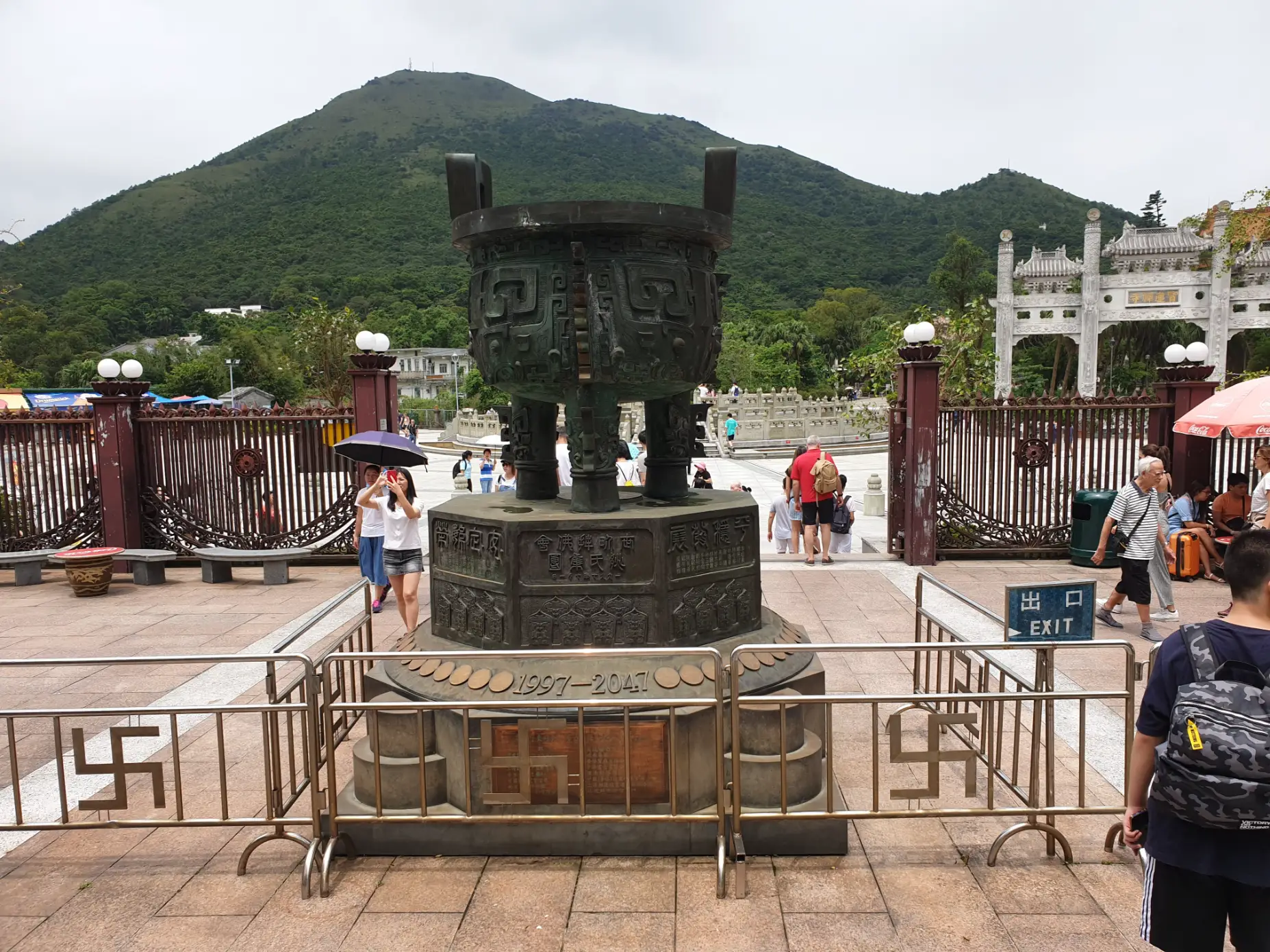
What made the experience even more special was hiking to the stunning Lantau Peak, also known as Fung Wong Shan, which offers breathtaking views and a peaceful escape from the city’s hustle and bustle. The hike was challenging yet incredibly rewarding, and it gave me a deeper appreciation for the natural beauty surrounding the Tian Tan Big Buddha. Beyond the Tian Tan Big Buddha itself, Lantau Island is full of nearby attractions worth exploring. From the tranquil Po Lin Monastery to the wisdom-filled Wisdom Path, there’s so much to see and do.
If you’re planning a visit, I highly recommend taking the time to explore not just the Tian Tan Big Buddha, but the entire Lantau Island. Whether you hike, take the Ngong Ping 360 cable car, or simply enjoy the serene surroundings, this destination is sure to leave a lasting impression on your heart and soul.
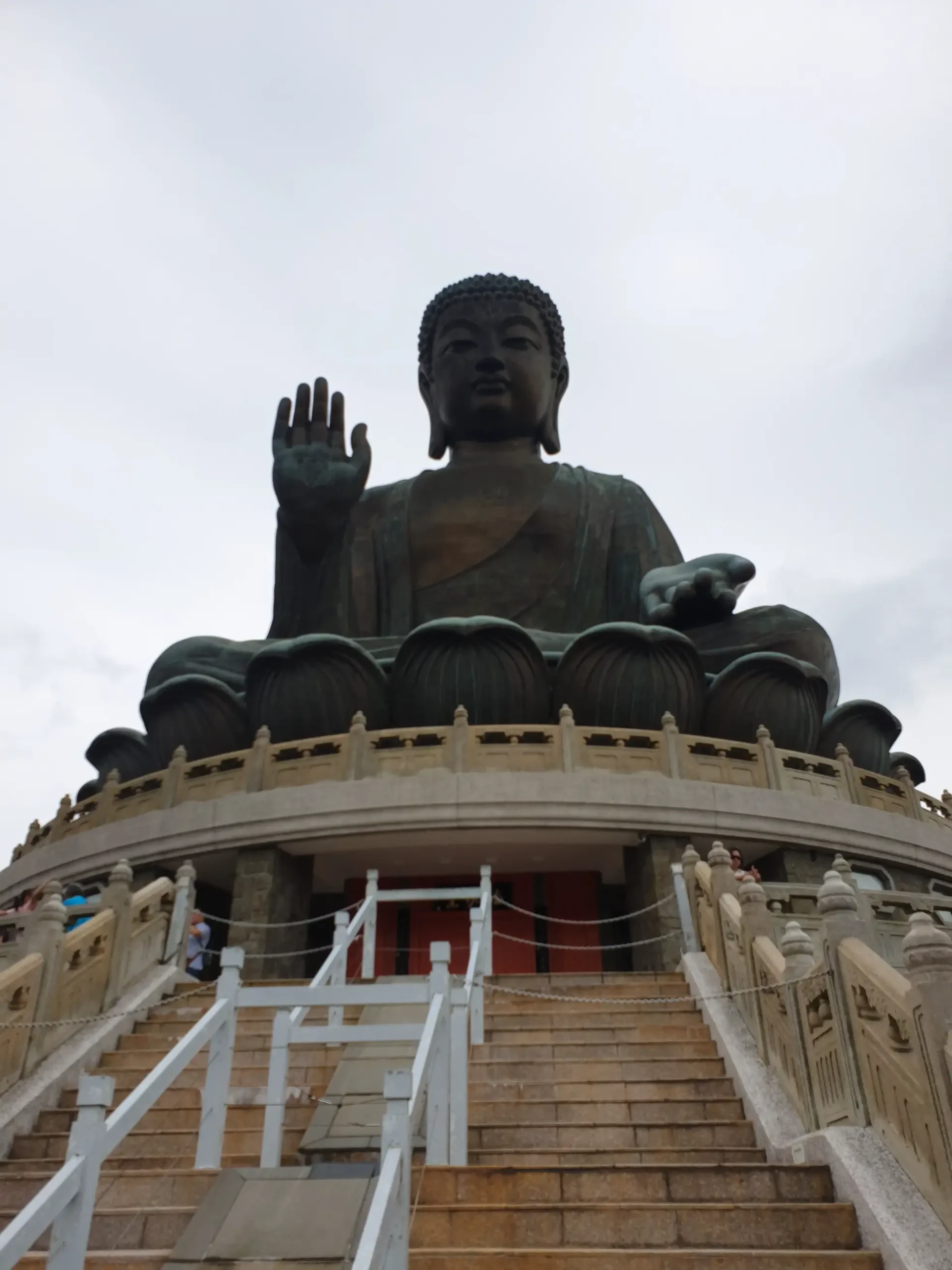
Let’s dive into everything you need to know about this extraordinary landmark, from its incredible size to the number of stairs you’ll need to climb!
Spiritual and Cultural Significance
The Big Buddha represents Siddhartha Gautama, the historical Buddha, in a seated meditative posture with a raised right hand signifying protection and a lowered left hand resting on the lap, symbolizing generosity. The calm expression on Buddha’s face invites contemplation, inner peace, and mindfulness.
The statue sits on a lotus throne atop a three-tiered base, echoing the design of the Altar of Heaven (Tian Tan) in Beijing. Surrounding the Buddha are six smaller bronze statues known as the “Offering of the Six Devas”, each holding symbolic items such as a flower, lamp, or fruit, representing the six perfections in Buddhism: generosity, morality, patience, diligence, meditation, and wisdom.
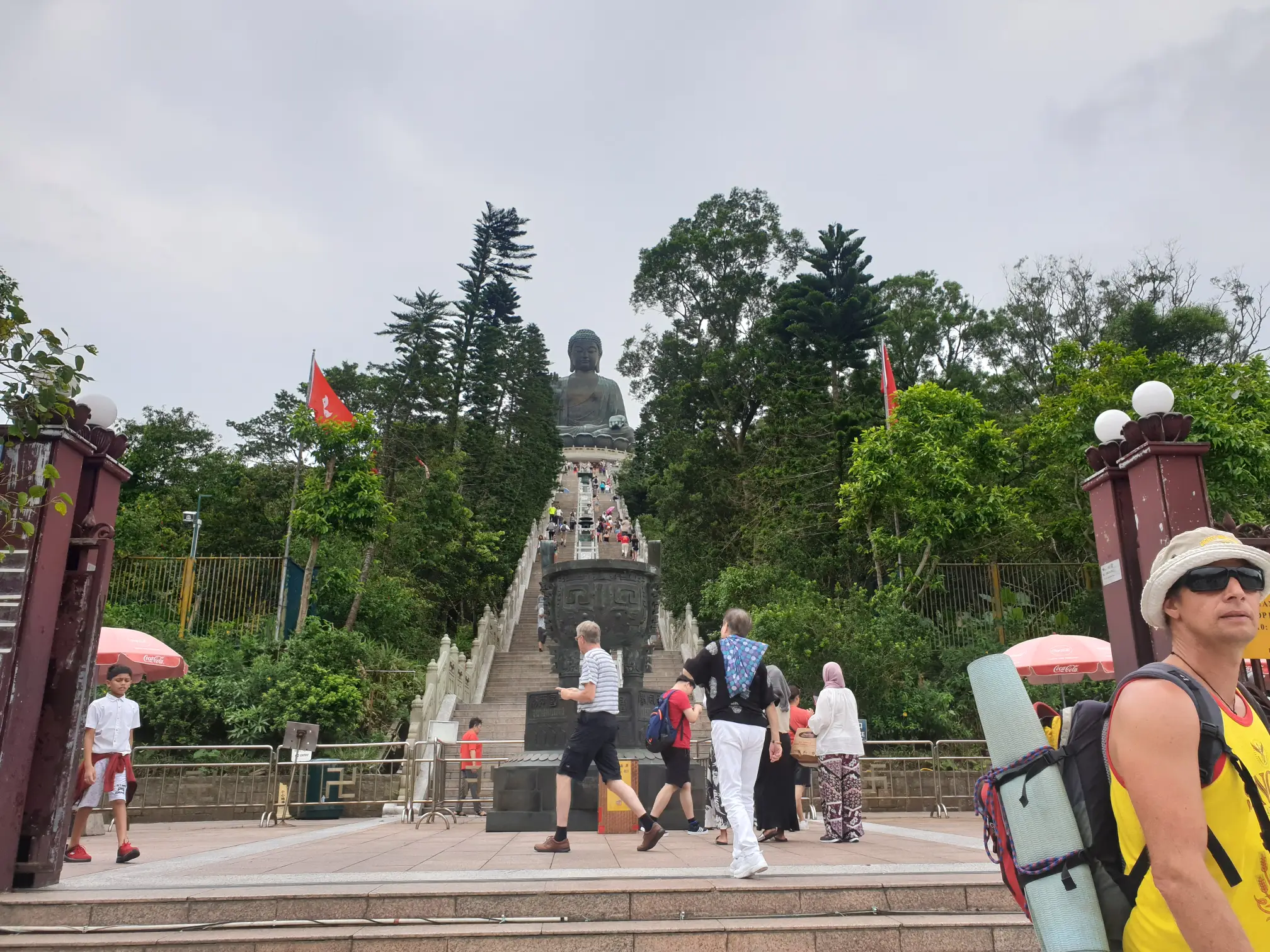
Meet the Tian Tan Big Buddha: How Big Is It, Really?
When we say the Big Buddha is big, we mean BIG. This stunning statue stands 34 meters (112 feet) tall, making it one of the tallest seated Buddha statues in the world. To put that in perspective, it’s roughly the height of a 10-story building!
Weighing an impressive 250 metric tons, the statue was cast in China in 202 bronze pieces and then transported to Hong Kong to be assembled at its current location. Completed in 1993, it has since become a symbol of Hong Kong’s rich cultural heritage and the harmony between people, nature, and faith.
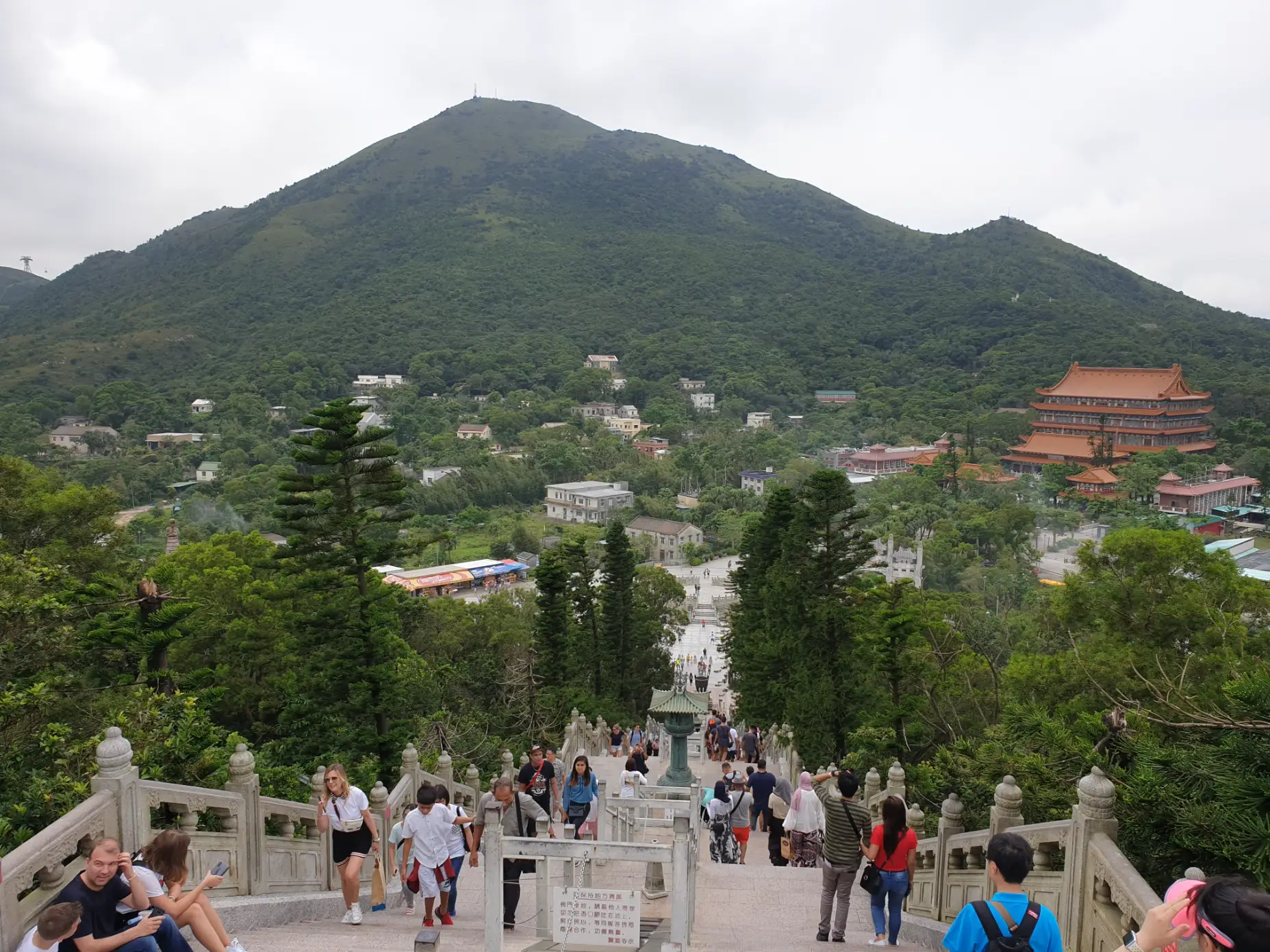
But it’s not just the size that’s impressive. The intricate craftsmanship, from the serene expression on the Buddha’s face to the detailed folds of his robe, reflects the dedication and artistry of those who created it.
Climbing to the Top: How Many Stairs Are in Tian Tan Big Buddha?
Getting up close and personal with the Tian Tan Big Buddha involves a bit of effort – specifically, 268 steps. Yes, you’ll need to climb your way to the top, but trust me, it’s worth every step! As you ascend, you’ll be treated to breathtaking views of the surrounding lush greenery, mountains, and the South China Sea.
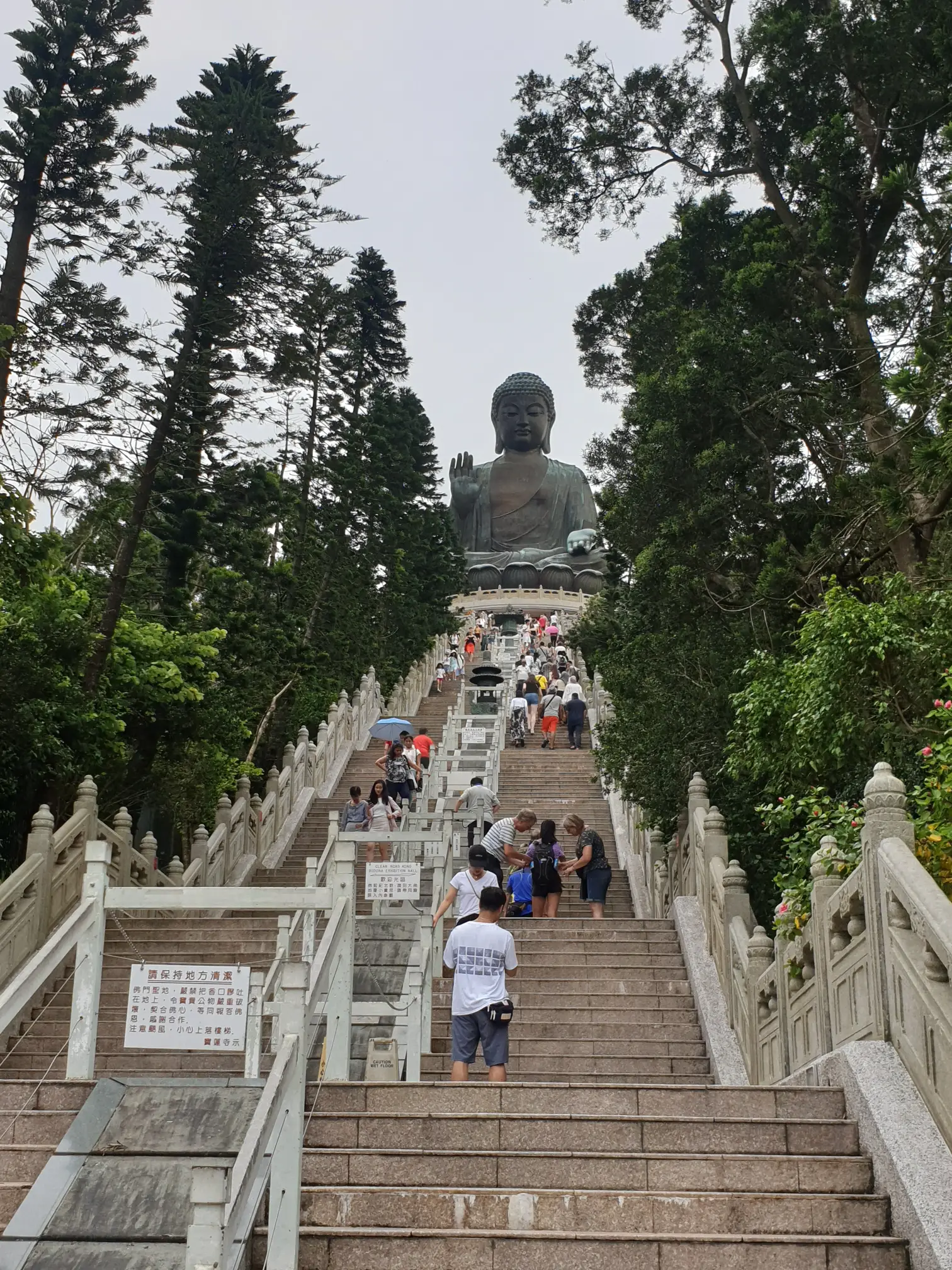
Don’t worry if you’re not in peak physical condition; you can take your time and rest along the way. The climb isn’t just about reaching the top; it’s about soaking in the peaceful atmosphere and taking a moment to appreciate the journey.
What’s Around the Tian Tan Big Buddha?
The Big Buddha isn’t standing alone up there. The entire area, known as the Ngong Ping Plateau, is packed with things to see and do. Here are some highlights:
1. Po Lin Monastery
Right next to the Tian Tan Big Buddha is the Po Lin Monastery, often called the “Buddhist World in the South.” Established in 1906, it’s one of the most important Buddhist temples in Hong Kong. The monastery features beautiful prayer halls, intricate statues, and a tranquil garden where you can enjoy a moment of peace.
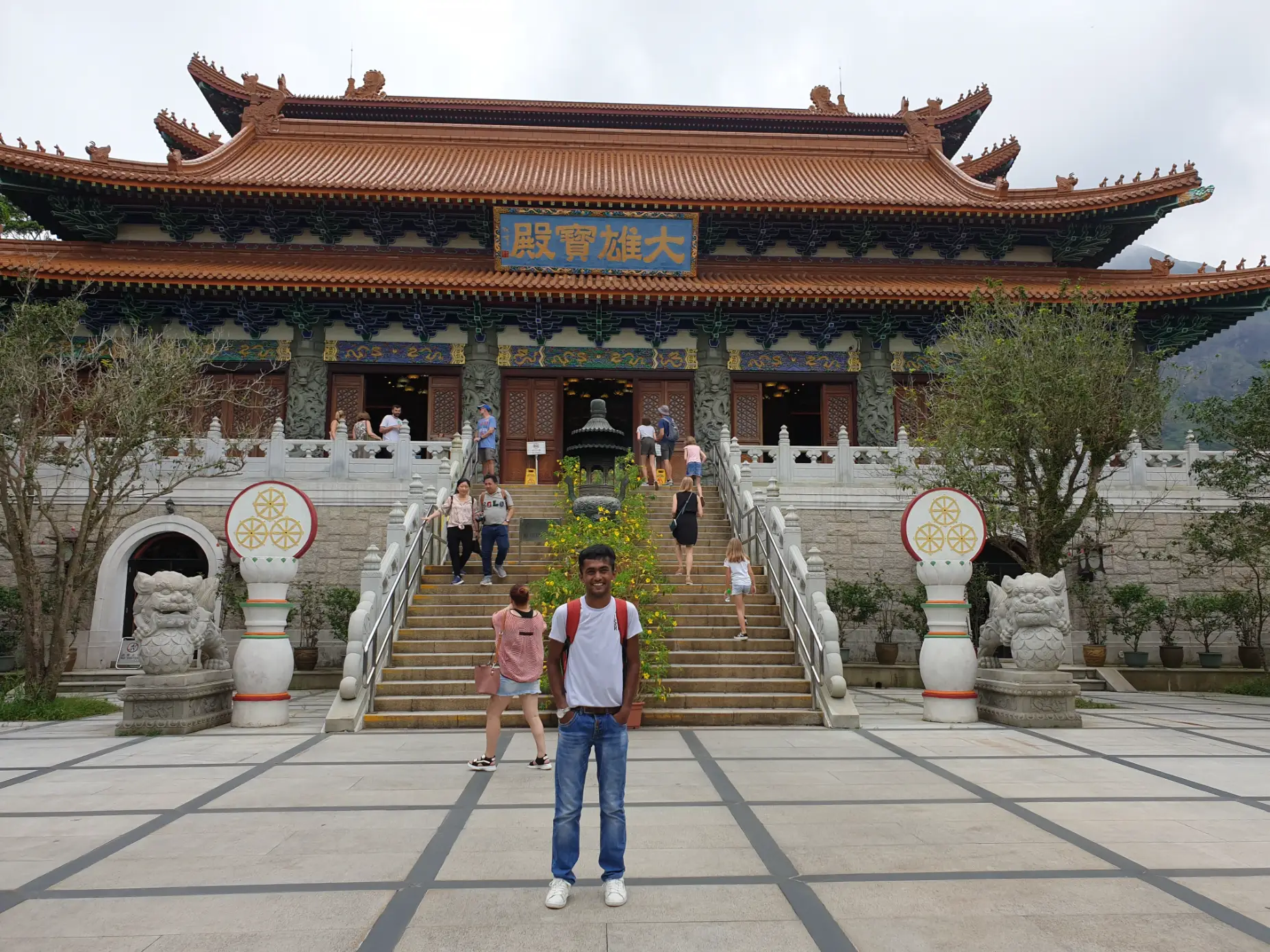
Don’t miss the vegetarian restaurant at the monastery! It’s famous for its simple yet delicious dishes, prepared in line with Buddhist traditions.
2. Wisdom Path
After getting down from the Tian Tan buddha If you’re up for a little walk, head over to the Wisdom Path, a short trail lined with 38 tall wooden steles. These steles are inscribed with the Heart Sutra, one of the most important prayers in Buddhism. The serene setting and the powerful words of the sutra make this spot perfect for meditation or quiet reflection.
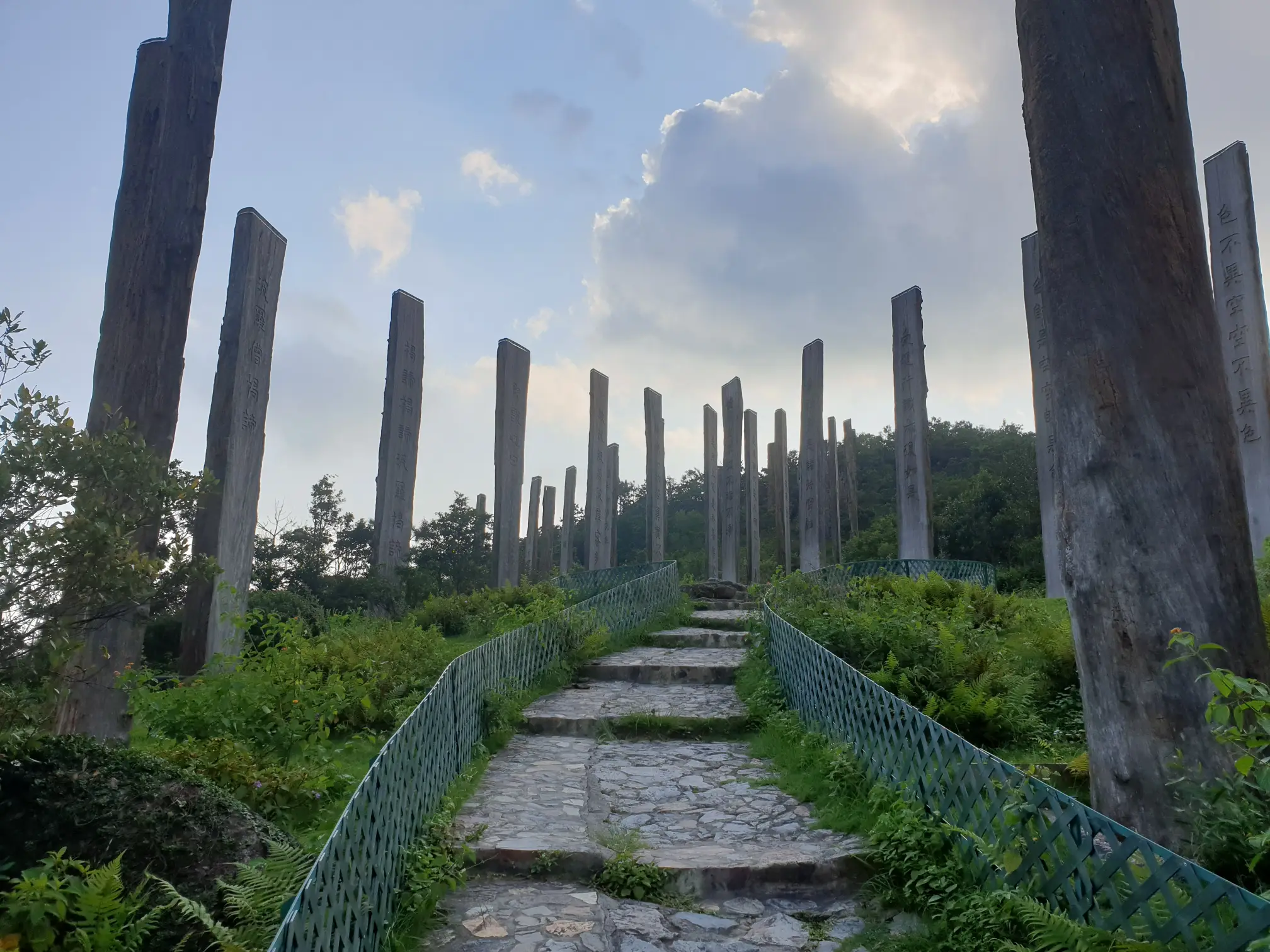
3. Ngong Ping Village
Before or after your visit to the Tian Tan Big Buddha, explore Ngong Ping Village, a charming cultural-themed area with shops, restaurants, and even street performances. It’s a great place to grab a souvenir or snack while soaking up the vibrant atmosphere.
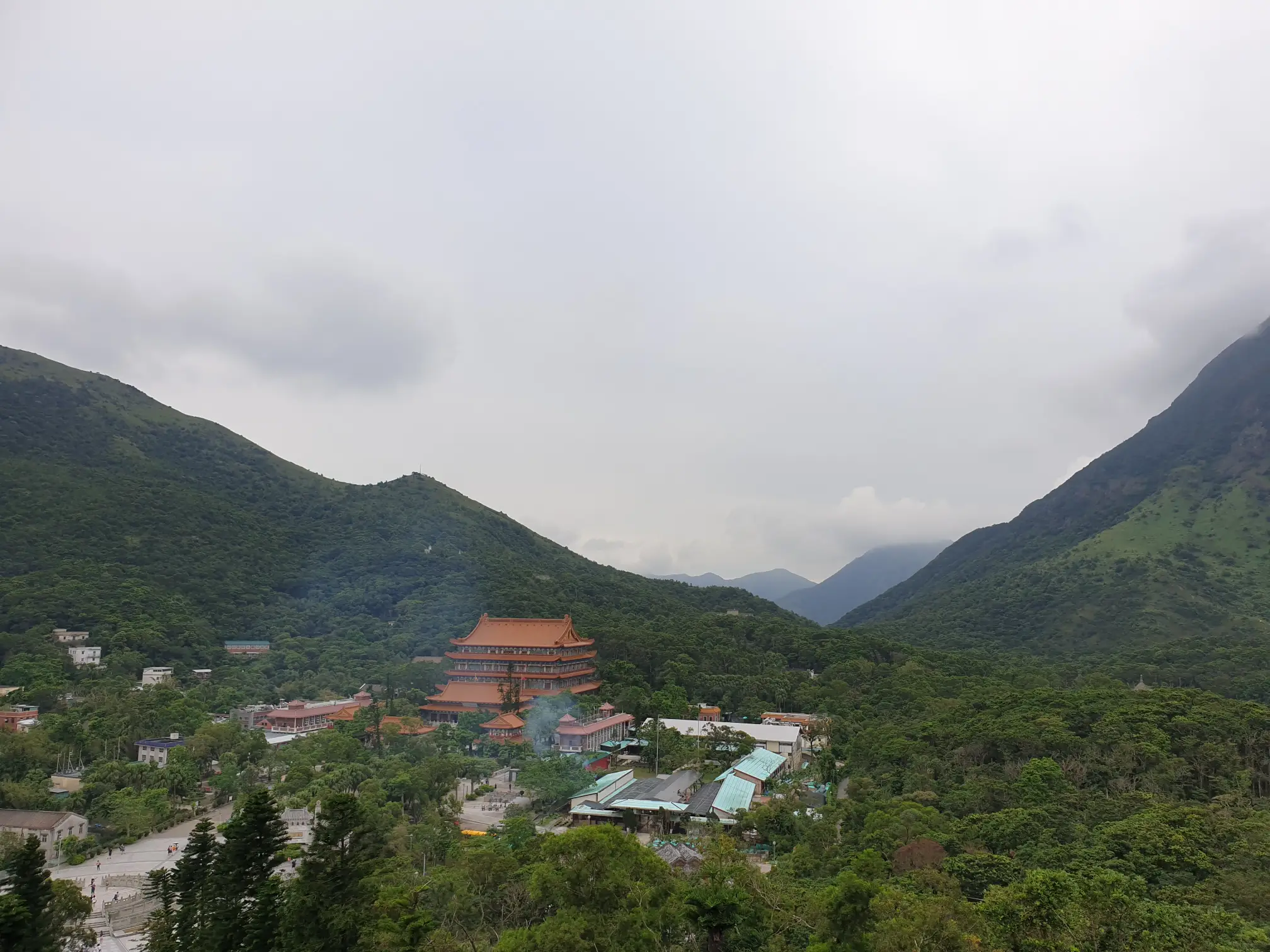
Lantau Peak
Rising to 934 meters (3,064 feet), Lantau Peak is the second-highest mountain in Hong Kong and a must-visit spot for nature lovers and adventure enthusiasts. It offers panoramic views of the surrounding landscapes, including Ngong Ping Plateau and the South China Sea. The hike to Lantau Peak is steep but manageable, with well-marked paths. Most visitors start from the Ngong Ping area or nearby Shek Pik Reservoir. The trail is approximately 4 kilometers and takes about 2 to 3 hours to complete, depending on your pace.
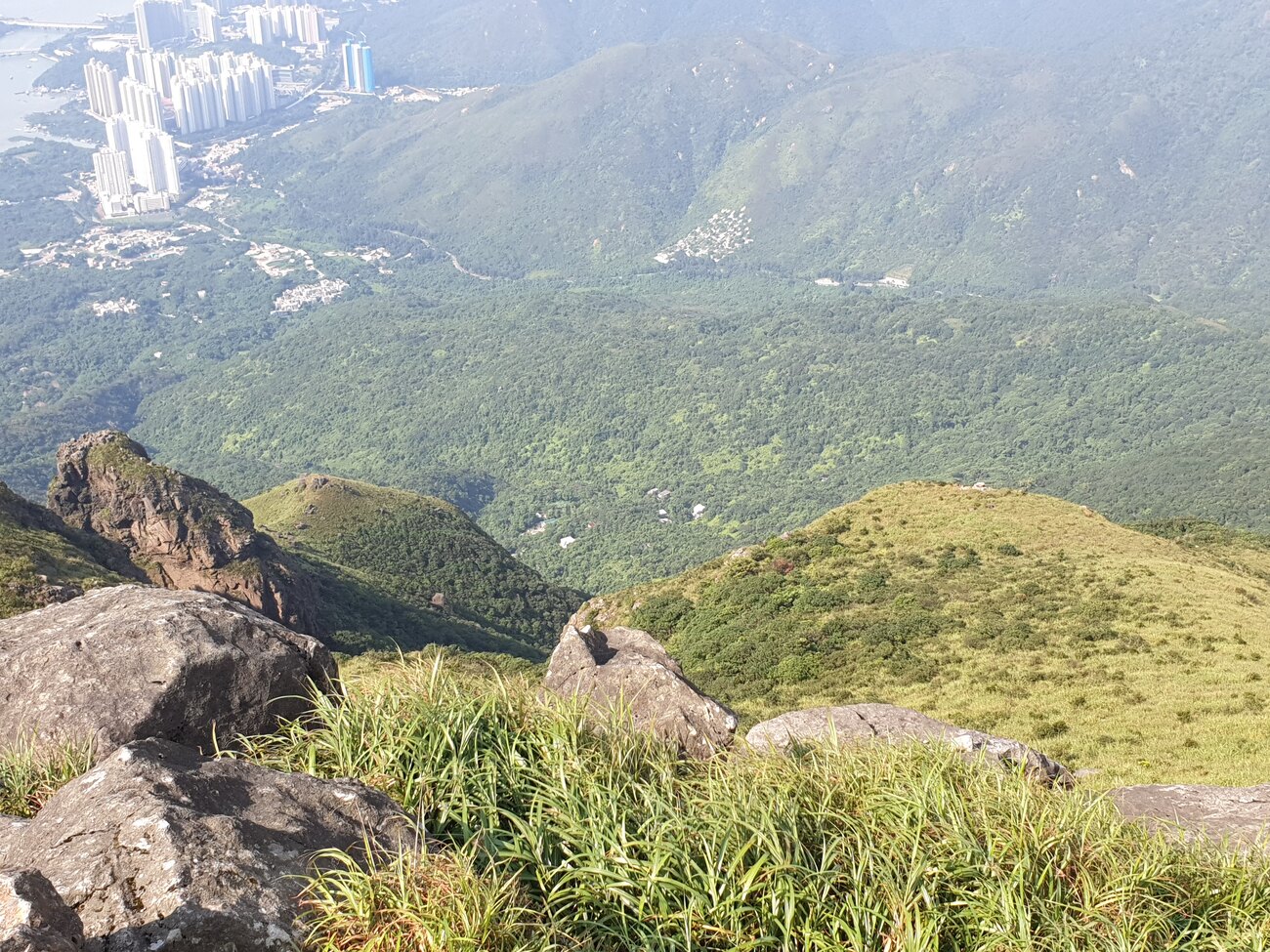
How to Get to the Tian Tan Big Buddha?
Reaching the Tian Tan Big Buddha is part of the adventure, offering breathtaking views and unforgettable experiences. Here are the main ways to get there, with detailed tips to make your journey smooth and enjoyable:
1. Ngong Ping 360 Cable Car
This is by far the most scenic and popular way to travel to the Tian Tan Big Buddha. Here’s everything you need to know:
- Starting Point: Tung Chung, easily accessible via the MTR (Mass Transit Railway).
- Duration: The cable car ride takes around 25 minutes one way.
- Highlights:
- Spectacular views of Lantau Island’s lush greenery, the South China Sea, and even the Hong Kong International Airport.
- The option of a Crystal Cabin, which features a glass floor for a thrilling experience as you soar above the landscape.
- Tips:
- Arrive early to avoid long queues, especially during weekends and holidays.
- Book tickets online in advance to save time and secure your preferred cabin type.
2. Getting Tian Tan Buddha by Bus
If you prefer a more economical route, buses are a great option.
- From Tung Chung: Take Bus 23 to Ngong Ping. The journey takes approximately 50 minutes and winds through scenic mountain roads.
- From Mui Wo (via ferry): If you’re coming from Central Hong Kong, take a ferry to Mui Wo and then hop on Bus 2 to Ngong Ping.
- Tips:
- Check bus schedules in advance, as services can be less frequent in the evening.
- Prepare for a slightly bumpy ride due to the winding roads.
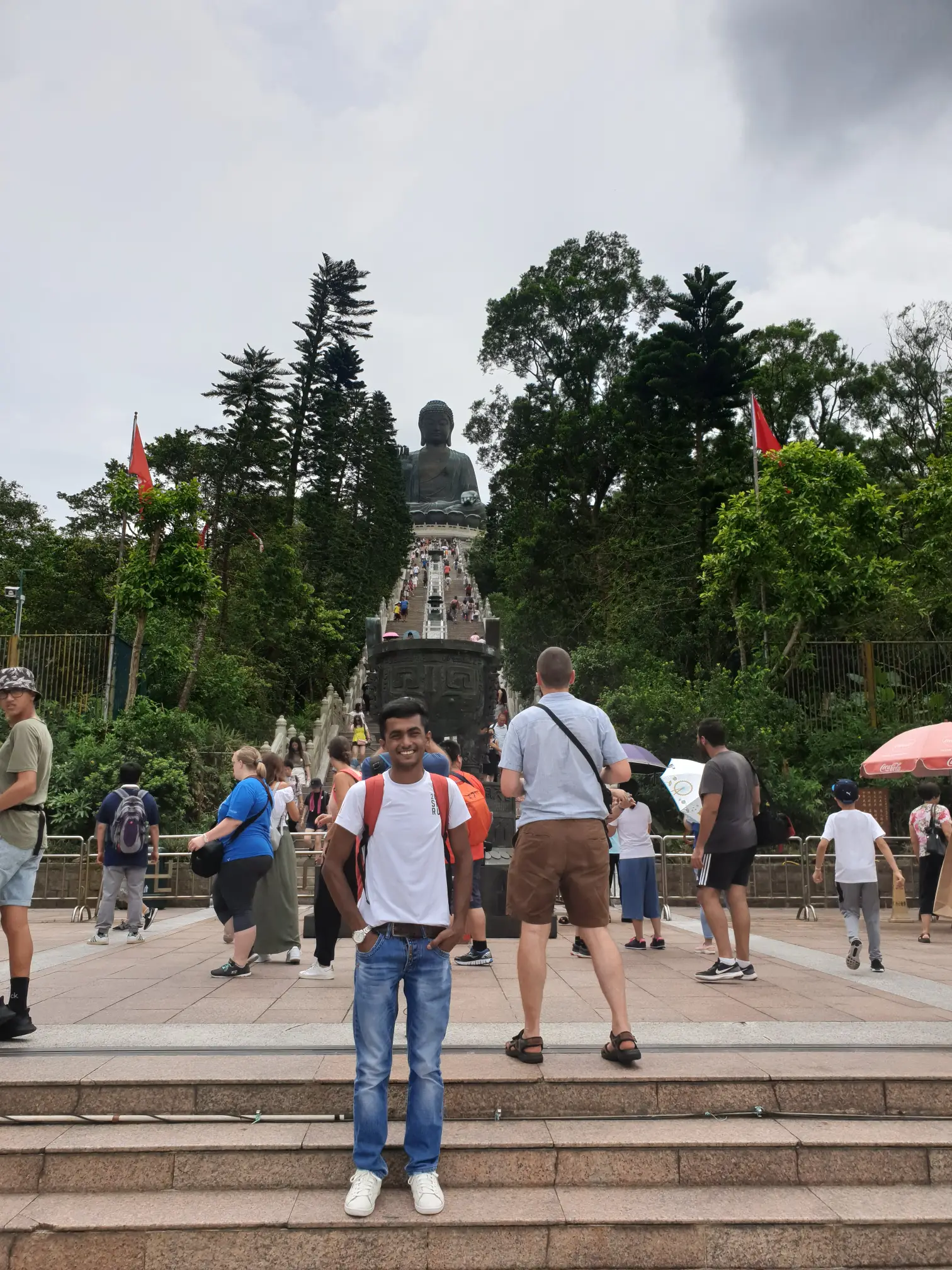
3. Hiking to the Big Buddha
For the adventurous and fitness-loving travelers, hiking to the Big Buddha is a rewarding experience.
- Popular Trails:
- The Ngong Ping Trail (from Tung Chung): A challenging yet scenic hike that takes around 2.5 to 3 hours.
- The Lantau Peak Sunrise Hike: Starting early in the morning, you can catch an unforgettable sunrise from Lantau Peak before heading to the Tian Tan Big Buddha.
- Tips:
- Wear sturdy hiking shoes and bring plenty of water.
- Check the weather forecast to avoid rain or slippery trails.
Basic Information: Tickets, Timings, and More for Tian Tan Big Buddha
Planning your visit is easy when you know the essential details:
- Opening Hours:
- The Big Buddha in Hong Kong open daily from 10:00 AM to 5:30 PM.
- The surrounding Ngong Ping area, including Po Lin Monastery, may have extended hours.
- Cable Car the Big Buddha Operating Hours:
- Weekdays: You can catch up the Cable car for Big Buddha from 10:00 AM to 6:00 PM.
- Weekends and Public Holidays: 9:00 AM – 6:30 PM
- Tickets for the Cable Car:
- Standard Cabin (Round Trip): HK$235 for adults, HK$110 for children.
- Crystal Cabin (Round Trip): HK$315 for adults, HK$190 for children.
- Combo packages are available for the cable car, vegetarian lunch at Po Lin Monastery, and more.
- Website for Booking:
- Official website: Ngong Ping 360
- Admission to the Tian Tan Big Buddha:
- Tian Tan Big Buddha is completely Free! However, there may be a small fee for entering the exhibition hall inside the statue.
Best Time to Visit
The Tian Tan Big Buddha is open year-round, but the best times to visit are:
- Spring (March-May) and Autumn (September-November): These seasons offer mild weather and clear skies, perfect for exploring.
- Early Morning or Late Afternoon: Visiting during these times helps you avoid the crowds and enjoy a more peaceful atmosphere.
Food Around the Tian Tan Big Buddha
Visiting the Big Buddha is not only a spiritual and cultural experience but also a chance to enjoy some delightful food. The Po Lin Monastery Vegetarian Restaurant is a must-visit for its simple yet flavorful Chinese vegetarian dishes, including tofu, spring rolls, and noodle soups. Their set menus, complete with tea, offer a peaceful dining experience that perfectly complements the serene atmosphere of the monastery.
For more variety, Ngong Ping Village has several cafés and restaurants serving everything from Cantonese dim sum to Western favorites like burgers and coffee, catering to different tastes. If you’re looking for quick bites, street food stalls in the village offer Hong Kong classics such as egg waffles, fried tofu, and herbal tea, perfect for a light snack after climbing the steps.
Alternatively, you can pack your own picnic and enjoy it amidst the beautiful natural surroundings, making for a relaxed and budget-friendly meal. With these options, you’re sure to find something satisfying to complement your visit to the Big Buddha.
Things to Look Out for When Visiting
While the Big Buddha and its surroundings are awe-inspiring, there are a few important things to keep in mind during your visit:
- Weather Check: The area can get misty, especially in the mornings or during winter, which might obscure your view. Try to visit on a clear day for the best experience.
- Photography Tips: The Big Buddha is a popular spot, so arrive early to beat the crowds and snap the best photos.
- Respect the Site: This is a place of worship, so dress modestly and be mindful of those praying or meditating.
Fun Facts About the Tian Tan Big Buddha
- North-Facing Buddha: Most Buddha statues face south, but the Big Buddha faces north, looking out over Mainland China. This is said to symbolize Buddha’s protection over the people.
- The Six Devas: Surrounding the Buddha are six smaller bronze statues, known as the Offering of the Six Devas. They hold objects like flowers and incense, symbolizing the six perfections of generosity, morality, patience, zeal, meditation, and wisdom.
- Sacred Relics: Inside the Buddha’s base is a small exhibition hall that houses a relic of Gautama Buddha himself – a bone fragment said to be sacred.
Visitor FAQ: What to Know About the Tian Tan Big Buddha
Yes, the Tian Tan Big Buddha is definitely worth visiting for its spiritual significance, stunning views, and serene atmosphere on Lantau Island.
You can reach the Big Buddha by taking the Ngong Ping 360 cable car, a bus from Tung Chung, or hiking the scenic trails on Lantau Island.
The Big Buddha is officially called the Tian Tan Buddha.
Plan for 2-3 hours to explore the Big Buddha, Po Lin Monastery, and nearby attractions
Yes, shorts are allowed, but it’s respectful to dress modestly when visiting the Po Lin Monastery nearby.
Absolutely! The Big Buddha is an iconic landmark offering a blend of spirituality, history, and natural beauty.
The Ngong Ping 360 cable car ride takes about 25 minutes one way.
No, visiting the Big Buddha is free, but there’s a small fee to enter the exhibition hall inside the statue.
There are 268 steps leading up to the Big Buddha.
Take the MTR to Tung Chung Station (Exit B), then either ride the Ngong Ping 360 cable car or take bus 23 to the Big Buddha.
Why You Shouldn’t Miss the Big Buddha
Whether you’re a seasoned traveler or someone just starting to explore the world, the Big Buddha offers something for everyone. It’s a place where culture, spirituality, and nature come together to create an unforgettable experience.
For some, it’s a spiritual journey, climbing the steps in search of peace and reflection. For others, it’s an awe-inspiring glimpse into Hong Kong’s rich Buddhist heritage. And for many, it’s simply a chance to take in the incredible views and snap some amazing photos.
